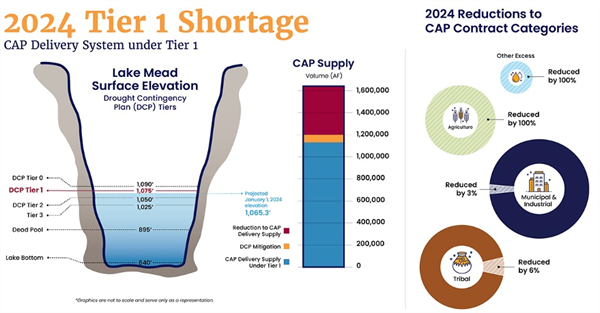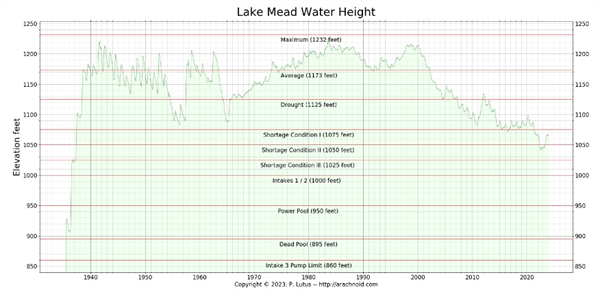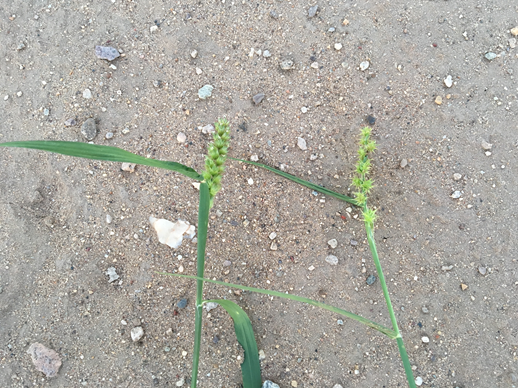
In 2023 Arizona and the lower basin states were operating under Tier 2 reductions, consistent with the Drought Contingency Plans (DCP) for Colorado River conservation in response to the drought conditions (Figure 1). Tier 2 conditions imposed a 592,000 acre-feet (kaf) reduction in Arizona’s 2.8 million acre-feet (maf) total allocation from the Colorado River. These reductions have primarily impacted the irrigation districts in central Arizona.
For 2024, the Bureaus of Reclamation (BoR) has announced in August 2023 that the river operations will follow Tier 1 DCP reductions (Figure 1). That is due to an increase in the water levels in Lake Mead in the past year with an excellent snowpack last winter and above average runoff in 2023. That increase in water level at Hoover Dam in Lake Mead is primarily a function of an excellent snowpack and higher rainfall in the Colorado River basin in 2023. Significant conservation efforts have been employed as well.

Figure 1. 2024 Tier 1 Shortage for the Colorado River operations. Source:
Arizona Department of Water Resources.
With agriculture responsible for 70% of the diversions on the Colorado River, tracking the snowpack is an important exercise for forecasting and managing the precious water resources in this region and this watershed for sure.
The pressures on the Colorado River system because of the drought that has been impacting the entire basin and region for 23 years have slackened briefly due to the wet winter in 2023 with a good snowpack in the mountains, good rainfall throughout the basin, good flows into the river, and conservation.
The current water level at Lake Mead on Hoover Dam is 1,068.25 ft. above sea level on 3 January 2024. That level is 160.75 ft below full pool of 1,229.00 ft. (Figure 2).

Figure 2. Lake Mead water height (feet above sea level at Hoover Dam) history
and critical Tier conditions. Source: U.S. Bureau of Reclamation.
The current snowpack in the Colorado River Basin is at 74% of average and below levels of this time last year. However, hydrological records indicate that most of the snowpack in this basin accumulates between February and April.
So, it is worth watching the snowpack accumulation and it is always good to pray for more snow in mountains to the north for those of us working and living in this desert with a heavy dependence on this water. However, while monitoring the snowpack gives us a capacity to project, none of that really counts until there is water in the river and in the reservoirs, like money in the bank.
I hope you are frolicking in the fields of wildflowers picking the prettiest bugs.
I was scheduled to interview for plant pathologist position at Yuma on October 18, 2019. Few weeks before that date, I emailed Dr. Palumbo asking about the agriculture system in Yuma and what will be expected of me. He sent me every information that one can think of, which at the time I thought oh how nice!
When I started the position here and saw how much he does and how much busy he stays, I was eternally grateful of the time he took to provide me all the information, especially to someone he did not know at all.
Fast forward to first month at my job someone told me that the community wants me to be the Palumbo of Plant Pathology and I remember thinking what a big thing to ask..
He was my next-door mentor, and I would stop by with questions all the time especially after passing of my predecessor Dr. Matheron. Dr. Palumbo was always there to answer any question, gave me that little boost I needed, a little courage to write that email I needed to write, a rigid answer to stand my ground if needed. And not to mention the plant diagnosis. When the submitted samples did not look like a pathogen, taking samples to his office where he would look for insects with his little handheld lenses was one of my favorite times.
I also got to work with him in couple of projects, and he would tell me “call me John”. Uhh no, that was never going to happen.. until my last interaction with him, I would fluster when I talked to him, I would get nervous to have one of my idols listening to ME? Most times, I would forget what I was going to ask but at the same time be incredibly flabbergasted by the fact that I get to work next to this legend of a man, and get his opinions about pest management. Though I really did not like giving talks after him, as honestly, I would have nothing to offer after he has talked. Every time he waved at me in a meeting, I would blush and keep smiling for minutes, and I always knew I will forever be a fangirl..
Until we meet again.
Mark C. Siemens, Department of Biosystems Engineering
Vol. 14, Issue 16, Published 8/9/2023
Pre-Season Vegetable IPM Workshop
Mark C. Siemens
Vol. 14, Issue 17, Published 8/23/2023
The Pre-Season Vegetable IPM Workshop will be taking place TOMORROW, Wednesday, August 23rd at the Yuma Agricultural Center. Come learn about the latest IPM products, practices and trial results from university and industry experts. Registration begins at 7:30 am and the program starts at 8:00 am. Agenda below. Looking forward to seeing everyone there!
|
Barnyardgrass |
Echinochloa crus-galli |
|
Red sprangletop |
Leptochloa filormus |
|
Prairie Cupgrass |
Eriochloa contracta |
|
Field sandbur |
Cenchrus spinifex |
|
Yellow foxtail |
Setaria glauca |
|
Feather fingergrass |
Chloris virgata |
|
Crowfootgrass |
Dactyloctenium aegyptium |
|
Junglerice (Watergrass) |
Echinochloa colona |
|
Mexican sprangletop |
Leptochloa fusca |
|
Southwestern Cupgrass |
Eriochloa acuminata |
|
Southern sandbur |
Cenchrus echinatus |
|
Green foxtail |
Setaria viridis |
|
Sixweeks grama |
Bouteloua barbata |

Figure 1. Left southern sandbur and right field sandbur